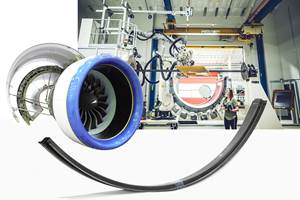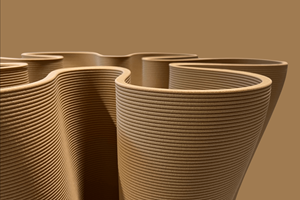We4Ce designs rotor blades for TouchWind’s floating one-piece rotor turbine
Tiltable, liftable one-piece composite rotor design aims to withstand storm-force winds, boost energy yield and enable more compact offshore wind farms.
The turbines are self-lifting and can withstand storm-force winds. Source | TouchWind
Rotor blade designer (Almelo, Netherlands) has announced the design of 10 rotor blade sets for Dutch wind turbine startup (Eindhoven, Netherlands) for testing on its floating TW6 turbine — a self-tilting, one-piece rotor design that breaks from conventional three-blade models. Engineered to withstand wind speeds of up to 250 kilometers/hour —the highest wind class in wind industry standards — the future commercial version is expected to cost significantly less than traditional turbines while delivering higher energy yields.
Responsible for the blade design, We4Ce partnered with mold specialist (Hengelo, Netherlands) to produce both the molds and blades. TouchWind, backed by its main shareholder, Mitsui O.S.K. Lines (MOL), contracted We4Ce as lead partner for the blades.
Delivery of the blades marks the next prototype phase of TouchWind’s tilting, one-piece rotor wind turbine. Featuring a 6-meter-diameter rotor designed for efficient energy capture, the 12-kilowatt turbines will be tested onshore and offshore. The turbines will be placed close to one another to validate the high energy density previously demonstrated in wind tunnel tests. Currently being assembled in Eindhoven, the wind turbine will start testing in summer 2025.
“We4Ce made a special structural design for the smaller blade compared to the default blades we see nowadays,” says Arnold Timmer, managing director of We4Ce. “For the aerodynamic design, the inventor, TouchWind’s Rikus van de Klippe, made a novel downwind self-tilting design. The rotor tilts upward, nearly parallel to the water surface at high wind speeds.”
The turbine functions similarly to a kite: Instead of pushing against the wind like traditional turbines, it “lifts itself” with the wind, using aerodynamic lift to stay stable and to regulate the power. This configuration enables the blade to harness strong winds more efficiently while reducing stress on the structure.
We4Ce and Kleizen worked together to produce the new rotor blade for TouchWind. Source | We4Ce
TouchWind’s design not only aims to reduce wind interference between wind turbines, a common issue in large wind farms, but also to improve overall wind farm power generation efficiency. It also reduces overall weight of both the wind turbine and its floating platform, contributing to simpler and more cost-effective deployment. Moreover, while conventional three-blade turbines shut down above 90 kilometers/hour to prevent load damage — a particular concern to the blade — TouchWind’s self-adjusting single rotor design minimizes load stress and remains operational in wind speeds up to 250 kilometers/hour.
To successfully produce the blades, We4Ce developed a novel production method using one-shot infusion for the central part of the rotor blade. By designing the aerodynamic shells to eliminate bonding lines in the nose area, the risk of leading edge erosion is significantly reduced — resulting in improved durability and higher annual energy yields.
Kleizen designed the complex mold that accommodated the blade geometry, tight tolerances and stringent performance requirements. “We were subsequently contracted to manufacture the entire rotor blades and we worked closely with We4Ce to apply the vacuum infusion approach for the production,” says Jeroen Maas, managing partner of Kleizen.
Kleizen used a two-component epoxy resin system, optimized for the resin infusion molding (RIM) process, which was combined with glass fiber reinforcement for strength, durability, and dimensional precision. The resin system underwent a carefully controlled post-cure process to achieve the mechanical properties.

Source | TouchWind
“We4Ce integrated engineering, processing and training expertise to enter this new wind turbine field. By combining our knowledge and skills, we successfully executed the order for TouchWind,” concludes Timmer.
Looking ahead, TouchWind has begun development of a 3-5-megawatt version of the turbine, aiming to scale its design for future offshore deployment. The wind turbines are suitable for more compact offshore wind farms and could be scaled further in the future.
Related Content
Bladder-assisted compression molding derivative produces complex, autoclave-quality automotive parts
HP Composites’ AirPower technology enables high-rate CFRP roof production with 50% energy savings for the Maserati MC20.
Read MoreThe potential for thermoplastic composite nacelles
Collins Aerospace draws on global team, decades of experience to demonstrate large, curved AFP and welded structures for the next generation of aircraft.
Read MoreSulapac introduces Sulapac Flow 1.7 to replace PLA, ABS and PP in FDM, FGF
Available as filament and granules for extrusion, new wood composite matches properties yet is compostable, eliminates microplastics and reduces carbon footprint.
Read MoreCutting 100 pounds, certification time for the X-59 nose cone
Swift Engineering used HyperX software to remove 100 pounds from 38-foot graphite/epoxy cored nose cone for X-59 supersonic aircraft.
Read MoreRead Next
Proteus Marine Renewables installs Japan’s first 1.1-megawatt tidal turbine
Carbon fiber tidal turbine generator, featuring a horizontal-axis rotor with three composite blades, drives Japan’s transition to tidal energy.
Read MoreAnemoi installs 35-meter-tall composite rotor sails on Sohar Max maritime vessel
Carbon fiber-reinforced epoxy composites are key to building these long-lasting wind propulsion technologies for energy-efficient watercraft.
Read MoreWe4Ce infused 2.5-3-MW rotor blade design passes validation test
Composite rotor blade structure design by We4Ce, mold and prototype production by InDutch Composites and fatigue testing by Suzlon Group has resulted in the novel blade’s IEC61400-5:2020 certification.
Read More












